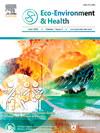Global modeling of photochemical reactions in lake water: A comparison between triplet sensitization and direct photolysis
引用次数: 0
Abstract
The equivalent monochromatic wavelength (EMW) approximation allowed us to predict the photochemical lifetimes of the lipid regulator metabolite clofibric acid (CLO, triplet sensitization) and of the non-steroidal anti-inflammatory drug diclofenac (DIC, direct photolysis + triplet sensitization) in lakes worldwide. To do so, we used large lake databases that collect photochemically significant parameters such as water depth and dissolved organic carbon, which allow for a preliminary assessment of some photoreactions. Extension to other photoreactions is currently prevented by the lack of important parameters such as water absorption spectrum, suspended solids, nitrate, nitrite, pH, and inorganic carbon on a global scale. It appears that triplet-sensitized CLO photodegradation would be strongly affected by the dissolved organic carbon values of the lake water and, for this reason, it would be fastest in Nordic environments. By contrast, direct photolysis (DIC) would be highly affected by sunlight irradiance and would proceed at the highest rates in the tropical belt. Interestingly, the predicted lifetimes of CLO and DIC are shorter than the residence time of water in the majority of global lake basins, which suggests a high potential for photoreactions to attenuate the two contaminants on a global scale. Photodegradation of DIC and CLO would also be important in waste stabilization ponds, except for elevated latitudes during winter, which makes these basins potentially cost-effective systems for the partial removal of these emerging contaminants from wastewater.

湖水中光化学反应的全球模拟:三重态敏化与直接光解的比较。
等效单色波长(EMW)近似使我们能够预测全球湖泊中脂质调节剂代谢物纤维酸(CLO,三重致敏)和非甾体抗炎药双氯芬酸(DIC,直接光解+三重致敏)的光化学寿命。为此,我们使用了大型湖泊数据库,这些数据库收集了光化学方面的重要参数,如水深和溶解的有机碳,从而可以对一些光反应进行初步评估。目前,由于缺乏重要的参数,如全球范围内的吸水光谱、悬浮固体、硝酸盐、亚硝酸盐、pH值和无机碳,因此无法扩展到其他光化学反应。三重敏化的CLO光降解似乎会受到湖水溶解有机碳值的强烈影响,因此,在北欧环境中它将是最快的。相比之下,直接光解(DIC)受阳光辐照度的影响很大,在热带地区进行的速率最高。有趣的是,在全球大多数湖盆中,CLO和DIC的预测寿命比水的停留时间短,这表明光反应在全球范围内减弱这两种污染物的潜力很大。除了冬季高纬度地区外,DIC和CLO的光降解在废物稳定池中也很重要,这使得这些盆地具有潜在的成本效益,可以从废水中部分去除这些新出现的污染物。
本文章由计算机程序翻译,如有差异,请以英文原文为准。
求助全文
约1分钟内获得全文
求助全文
来源期刊

Eco-Environment & Health
环境科学与生态学-生态、环境与健康
CiteScore
11.00
自引率
0.00%
发文量
18
审稿时长
22 days
期刊介绍:
Eco-Environment & Health (EEH) is an international and multidisciplinary peer-reviewed journal designed for publications on the frontiers of the ecology, environment and health as well as their related disciplines. EEH focuses on the concept of “One Health” to promote green and sustainable development, dealing with the interactions among ecology, environment and health, and the underlying mechanisms and interventions. Our mission is to be one of the most important flagship journals in the field of environmental health.
Scopes
EEH covers a variety of research areas, including but not limited to ecology and biodiversity conservation, environmental behaviors and bioprocesses of emerging contaminants, human exposure and health effects, and evaluation, management and regulation of environmental risks. The key topics of EEH include:
1) Ecology and Biodiversity Conservation
Biodiversity
Ecological restoration
Ecological safety
Protected area
2) Environmental and Biological Fate of Emerging Contaminants
Environmental behaviors
Environmental processes
Environmental microbiology
3) Human Exposure and Health Effects
Environmental toxicology
Environmental epidemiology
Environmental health risk
Food safety
4) Evaluation, Management and Regulation of Environmental Risks
Chemical safety
Environmental policy
Health policy
Health economics
Environmental remediation
 求助内容:
求助内容: 应助结果提醒方式:
应助结果提醒方式:


